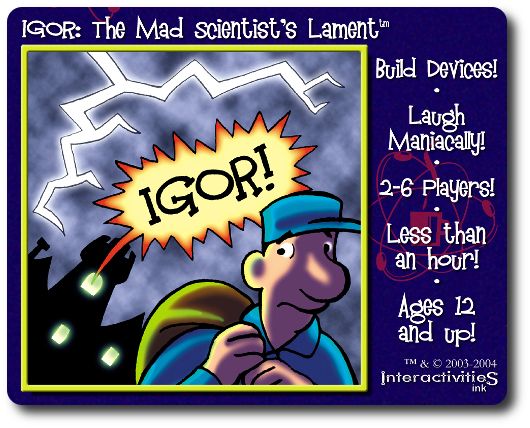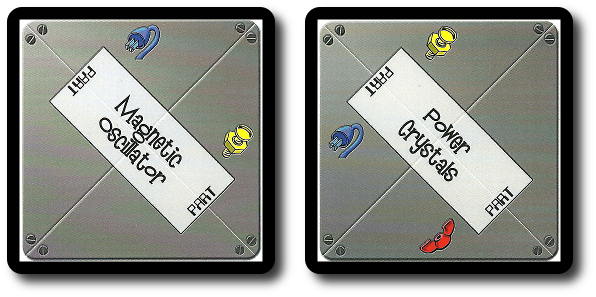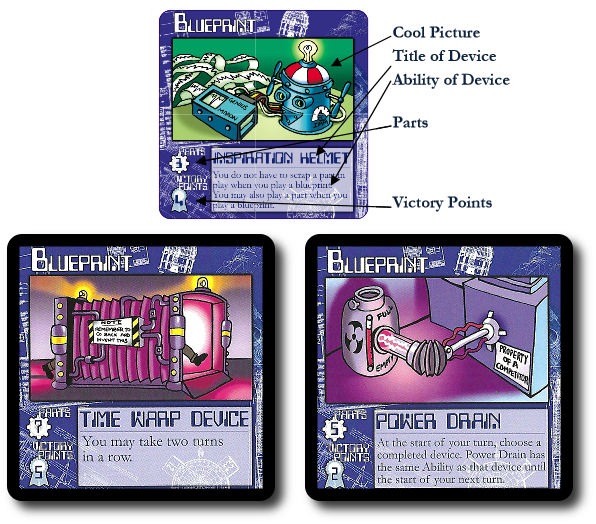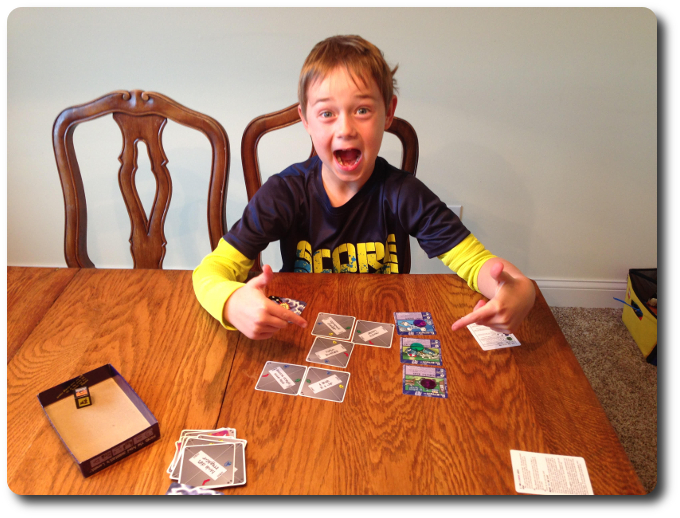
The Basics:
- For ages 8 and up (publishers suggests 12+)
- For 2 to 6 players
- Approximately 45 minutes to complete
Geek Skills:
- Counting & Math
- Logical & Critical Decision Making
- Reading
- Pattern/Color Matching
- Strategy & Tactics
- Risk vs. Reward
- Hand/Resource Management
Learning Curve:
- Child – Easy
- Adult – Easy
Theme & Narrative:
- It’s tough being a Mad Scientist when your help is less than helpful
Endorsements:
- Gamer Geek mixed!
- Parent Geek approved!
- Child Geek approved!
Overview
It’s hard being a mad scientist. First, there is the angry mob of villagers that are always at your door. Second, it’s impossible to get a pizza delivered when your home is surrounded by pitchforks and torches. Worst of all, you have been cursed with an incredibly incompetent assistant. One day you won’t need him, but for now, he’s all you got.
IGOR: The Mad Scientist’s Lament, designed by Mike Young and published via the Game Crafter, is comprised of 84 cards (21 Blueprint cards, 46 Part cards, and 17 Megalomaniac Laughter cards), 16 Completed tokens, 4 Reminder cards, and 4 IGOR dice (custom six-sided die). The cards are square (except for the Reminder cards) and are as thick and as durable as your standard playing card. The tokens are plastic winks that lack much in the way of “pizzazz”, but do their job beautifully in the game. The IGOR dice are plastic, as well. Artist Alexander Bradley lends his talents by illustrating the many strange inventions the players will attempt to create with the help of their incompetent assistant.
To the Lab!
To set up the game, first shuffle and deal each player 7 cards, face-down. Players should look at their cards but keep them hidden from their opponents until played.
Second, deal 5 cards face-up in pile to create the Junkyard. The Junkyard serves as the discard pile during the game.
Third, place the remaining cards face-down next to the Junkyard and within easy reach of all the other players. This is the draw deck.
Fourth, place the Completed tokens to one side of the game playing area and give each player 1 IGOR die (or share them) and 1 Reminder card. Place any dice and Reminder cards not used back in the game box.
That’s it for game set up. Determine who will be the first player and begin.
A Mad Scientist’s Tool Belt
Today’s Mad Scientists are very lucky. There’s an endless supply of useful bits that can be used to create world-dominating devices of mass mayhem. The trick is getting the right ones. Unfortunately, due to your unsavory reputation, you’ve been forced to barricade yourself in your mansion on the hill. Your loyal but inept helper, Igor, will happily look for what you need. Don’t expect to get what you ask for, but you can always use what Igor brings back.
There are 3 different card types in the game. A Mad Scientist needs to know how to use each to further their goal of world domination.
Part Cards
These cards represent 1 specific part that can be used to create a device. Parts range from Gummy Worms to gears. Each Part card will have 1 to 4 connectors represented by a colored component. In order to be played, Part cards need to connect to each other by matching colored components. The first Part card played need not connect to anything. After that, each additional Part card played must connect to at least 1 previously played Part card.

Blueprint Cards
Blueprint cards represent the devices the players are attempting to build. A player must discard 1 Part card to bring it into play, but once it’s out, the player can complete it anytime if they have the correct number of Part cards in play. If they do, the player discards the correct number of Part cards and places a Completed token on the Blueprint card, signifying that the Blueprint card is now a fully functional device. Some devices will have special effects and abilities, making them very useful. Regardless, all completed devices award the player victory points which are necessary to win the game.

Megalomaniac Laughter Cards
These cards interrupt opponents and give the player an opportunity to bend some of the game rules. Each Megalomaniac Laughter card describes when it can be used and the card’s effects.

Madness: The Mother of Invention
IGOR: The Mad Scientist’s Lament is played in turns with no set number of turns per game. A player’s turn is comprised of several steps and actions. A typical player’s turn is summarized here.
Step 0: Non-Action Actions
There are several actions that a player can take at anytime during their turn that do not actually count as actions. The player is never forced to use these non-actions and they won’t be of much use to the player until the situation calls for it or the right card is ready to play.
Build a Device
If the player has a Blueprint card and the correct number of Part cards in play, they can discard the correct number of Part cards and place a Completed token on the Blueprint card. The Blueprint card is now considered a fully functional device and can be activated for its effects. The player also earns the victory points listed on the Blueprint card.
Scrap Cards
Anytime during the player’s turn, they can scrap a Part or Blueprint card from play. This is necessary at times in order to activate a card or to bring another card into play. Blueprint and Part cards always go to the top of the Junkyard when they are scrapped.
Laugh Like a Lunatic
Megalomaniac Laughter cards can be played at anytime during the player’s turn, but only when the card to be played specifically says so. For example, some Megalomaniac Laughter cards must be played immediately after an opponent rolls the IGOR die. Unlike Part and Blueprint cards, Megalomaniac Laughter cards are placed on the bottom of the Junkyard when they are played or scrapped.
Use Device
Some completed Blueprint cards provide the player with special abilities and actions that can be used at anytime during the player’s turn or only during specific steps. The player should consult their completed Blueprint cards to ensure they are using them correctly.
Step 1: Start of Turn Actions and Effects
When the game first begins, none of the players will have any completed devices in front of them that they can use. This will quickly change. Some devices the players can create have special actions and effects that are triggered when it’s the player’s turn. If the player has more than one device with a start of turn effect or ability, they may choose the order in which they are resolved.
Step 2: Send Igor On An Errand
Igor is a complete a total nincompoop, but his heart is in the right place. If you ask him to bring you a glass of milk, he’ll fetch you a cow. It’s not that Igor is dumb, it’s that he’s really dumb. In game terms, Igor’s actions are out of your control and the outcome of his attempt to assist you is randomly determined by rolling the IGOR die. There are six possible results. None of them will hurt he player, but nor is the result guaranteed to be beneficial to the player.
- Steal 1 Part card owned by an opponent that is only connected to one other Part card. When taken, play it immediately.
- Steal 1 card from an opponent’s hand and place it in your hand
- Draw 1 card from the draw deck
- Play 1 Part card from your hand
- Draw the top card from the Junkyard and add it to your hand
- Select any action noted above
After rolling the die, the action is resolved. If the action cannot be resolved or is canceled by an opponent, the action is then ignored. Either way, this step of the player’s turn is over.
Step 3: If You Want Something Done Right…
During this step, the player can take 1 action of their choice. Thematically speaking, this is the action taken by the Mad Scientist who is sick and tired of Igor’s bumbling.
Play One Part Card
Any Part card in the player’s hand can be played to the table in front of them, but it must be properly connected to at least 1 other previously played Part card. Part cards can be orientated in any way the player likes, but once they are on the table, they are locked until discarded. Players will also want to attempt to connect their Part cards to as many other Part cards as possible. Part cards can be stolen but are safe from would-be thieves if the card is connected to 2 or more other Part cards.
Play One Blueprint Card
Any Blueprint card can be brought into play, but a player can only have 1 Blueprint card in front of them at a time. There is no limit to the number of completed Blueprint cards (which are considered “devices”) a player can have. If the player wants to bring out a new Blueprint card, they must scrap (discard) their previously placed incomplete Blueprint card. This is done at the same time as playing the Blueprint card and does not count as an additional action. The player must also scrap 1 Part card of their choice that is currently in play, as well. However, if the player does not, they can still play the Blueprint card.
Draw One Card
The player can also draw the top-most card from the draw deck and add it to their hand, but doing so restricts the player from taking any additional actions on their turn. There is no hand size limit.
After the player takes their turn, the next player in turn order sequence takes their turn using the steps noted above. This continues until the game is won.
I’VE DONE IT!!!!
Play continues as summarized above until 1 player has earned a total of 10 victory points which are provided by completed Blueprint cards. This player is truly the maddest of the mad!
Game Variants
There are a few different ways to play the game for those who like to change things up a bit.
Longer and Shorter Games
The end of the game is determined by the total number of victory points that must be earned. Ten victory points is the default, but you can easily make the game longer by making the goal 15 victory points or more. Likewise, a shorter game can be had by limiting the number of necessary victory points to 8 or less.
Own the Madness
It’s suggested in the game’s rules that players should avoid “just rolling the dice”. Instead, they should act out the part of a Mad Scientist. Players are encouraged to laugh evilly, curse Igor under their breath, and launch into overly detailed monologues about how their single card play heralds the end of mankind. Players are even encouraged to wear outfits, such as lab coats and crazy wigs. All in fun, mind you, as doing any of this has no impact on the game.
To learn more about IGOR: The Mad Scientist’s Lament, visit the game’s web page.
Final Word
The Child Geeks had a lot of fun acting out the part of a Mad Scientist. They laughed as evilly as they could (which actually sounded really cute) and correctly played Part and Blueprint cards like the evil geniuses they are. They also used the Megalomaniac Laughter cards very well, causing problems for their opponents whenever they could. The only aspect of the game they didn’t like was Igor. According to one Child Geek, “I like everything about this game except my assistant. He can’t do anything right!” Another Child Geek said, “I like how you have to build your device and then get to use it, but I don’t like having to depend on Igor to find me parts.” While all the Child Geeks agreed that Igor was more trouble than what he was worth, they also all agreed that the game was a lot of fun. All the Child Geeks voted to approve IGOR: The Mad Scientist’s Lament.

My son cheers and then laughs evilly as he builds his final device to win the game!
The Parent Geeks also enjoyed the game, finding it to be fun, fast, and casual with just the right amount of depth of play and player interaction to make it a lot of fun. According to one Parent Geek, “I like games like this. There is a puzzle element, risk, reward, and even some strategy to go along with it. But it plays fast and light. This is a great family game.” Like the Child Geeks, the Parent Geeks found Igor to be an incompetent boob, but they found that the random outcomes of the die served to further strengthen the game’s theme and narrative. In the end, they forgave Igor and warmly embraced the game, fully approving it for friends and family.
The Gamer Geeks found IGOR: The Mad Scientist’s Lament to be light and casual. From there, the elitists split into two groups. One group fond IGOR to be a decent filler game, believing it to be just deep enough to keep players engaged and working towards their goals with a sense of urgency. According to one Gamer Geek, “I found the game to be entertaining, although not overly challenging. You have to work to win and the real challenge is determining if you should build a lot of smaller devices or hold out and build the big ones. I liked it.” The other group found IGOR to be too light and too random to be a game they would consider playing. According to one of these Gamer Geeks, “The IGOR die is terrible. I always get one action choice and a random one. The random action is never bad, but nor is it always what I want to do. I don’t care for games that decide what I do. I can do my own thinking, thank you very much.” When all the games were over, the Gamer Geeks remained split, with one group welcoming Igor back to their gaming table and the other group chasing him off with pitchforks and torches.
IGOR: The Mad Scientist’s Lament is fun little game, but it won’t challenge gaming elitists. Nor will it ever cause problems for less skilled and more casual players. The game is very easy to learn and plays fairly quickly. Where the game begins to bog down is the IGOR die that will always provide the player an action, but not necessarily a useful action. This can cause delays and players will have to work around lack of resources and missed opportunities to collect cards. But at no time is a player ever stuck. Players will be, at the very most, slowed down, but never fully stopped from taking meaningful actions.
I found the game to be perfect for families, but not my first choice as a game filler. It’s a bit too random for my taste and I spent most of the time feeling like I wanted more control over what I was building. Stealing other player’s cards and causing general disruptions reduced the game to little more than quick card plays and lucky rolls of the die. I still had fun, but the game never elevated itself to a point where I felt like I would play it with gaming elitists. I have never once said no to playing the game with family and friends, however. The game plays great with younger and casual players. Especially if you ham it up a bit.
IGOR: The Mad Scientist’s Lament teaches us that behind every brilliant individual is a moron who will screw things up. Not the kind of life lesson you necessarily want to teach your children, but there is wisdom in making sure you depend on the right people. Which, to be honest, is a much deeper lesson than this delightful little game ever intended to teach. If you enjoy a game with a light challenge, quick card plays, and dice that never really do exactly what you want, then do play IGOR: The Mad Scientist’s Lament. It won’t drive you crazy, but it will most likely make you seriously consider throwing Igor out the window.
This game was given to Father Geek as a review copy. Father Geek was not paid, bribed, wined, dined, or threatened in vain hopes of influencing this review. Such is the statuesque and legendary integrity of Father Geek.



